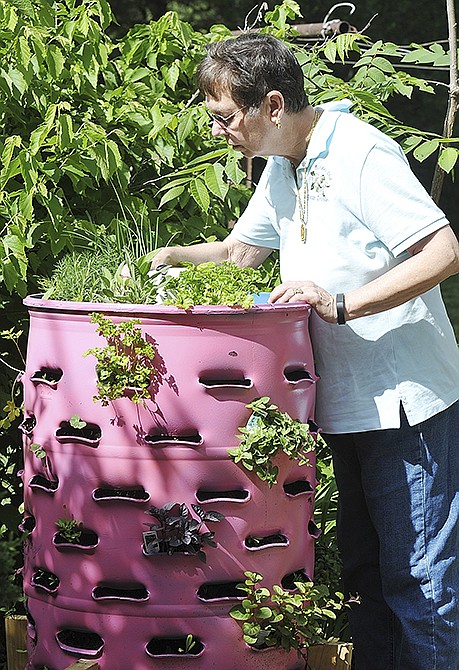Using simple and sometimes unexpected materials for container gardening can provide practical solutions for growing plants, according to local Master Gardener Jeanne Schwaller.
Whether consulting abroad or working at home, Schwaller uses a variety of different methods to container garden.
During her career as an international agricultural consultant, Schwaller traveled extensively, working on government projects with landowners and farmers to grow vegetables in developing countries.
"When we were working in the Dominican Republic, we were working with people that had really no income, and we were trying to grow tomato plants on top of their goat sheds. We would use beer cans and put old cotton socks that were really holey in a container," Schwaller said.
The aluminum cans were light enough to put on top of the goat sheds, she noted. They punctured holes in the bottom of the cans to drain excess water and inserted socks to hold the roots. They filled the cans with a mixture of goat manure and water to grow greens, peppers and tomatoes.
In Russia, Schwaller worked on a project that focused on the use of concrete space to create a garden.
"You have to picture the very, very large Russian concrete apartment blocks in the major cities - Moscow, St. Petersburg - and I worked in St. Petersburg," Schwaller said.
She worked with others to grow plants on the balconies and used bags of topsoil to grow plants on the flat roofs. Although they grew both lettuce and tomatoes, they mainly targeted lettuce because it was in limited supply.
They also had to overcome a few challenges in providing water to plants in Russian cities.
"The big problem was the water pressure. So we had to water the garden at, like, 4:30 in the morning because people weren't using water in the apartments and there would be enough pressure to push the water up in the hose," Schwaller said.
At her Jefferson City home, Schwaller maintains a tropical garden in her basement greenhouse and takes the plants outside during the summer months. At the far end of her backyard sits a row of large containers with a few cool-season crops. The green shoots of lettuce bud out of the soil, and wire mesh lays on top of the beets to protect them from squirrels. Beyond the containers, her small garden plot lays unperturbed.
"Vegetable container gardening I have exclusively done for two years because I didn't have anyone to till my garden," Schwaller said.
Before her husband passed away, they considered building a movable garden. The structure "was going to be (made with) plywood on these big wheels, and you could just take a rope and move this thing around to where the sun was," Schwaller said.
Along her back porch, Norton grape vines form an archway. A few fruit trees and a hazelnut tree create plenty of shade in her backyard when in full bloom.
"When these trees leaf out, there is absolutely no sun in the yard at all. I can't grow tomato plants. The Norton grapes, they will never have a grape on them," Schwaller said.
Her small garden plot, however, is far enough away from the trees to receive sunlight.
Compared to regular ground gardening, container gardening is easier for her now that she gardens on her own. Yet it can have some setbacks.
"You just don't have all of the conditions that you need. So when you put a plant in and you constrict its roots, you lose productivity," Schwaller said.
A benefit of container gardening is that it is less labor intensive.
"You don't have to bend over a lot," she said.
In containers, gardeners can easily move plants to areas were there is sunlight. Schwaller advises containers be at least 12 inches deep. If containers are deeper, she suggests people use filler material, such as rocks, cheap soil, shredded paper and shipping peanuts, to fill the extra space.
"Vegetables roots will go down 12 inches; that is not a deep-rooted plant," Schwaller said.
As with gardening in the ground, unexpected temperature drops may also affect potted plants. Last year, Schwaller and her grandkids took out her staghorn fern from her greenhouse on Mother's Day because the temperature had dropped to 28 degrees.
"That would've killed it," Schwaller said. "So here I am on a ladder with hammer and nails and hammering blankets up all around this, and then I'm putting lights on poles to keep the area warm."
The staghorn weighed several hundred pounds, which was too heavy for one person to move alone. This year, she will wait for warm weather this month to take the plant outside.

